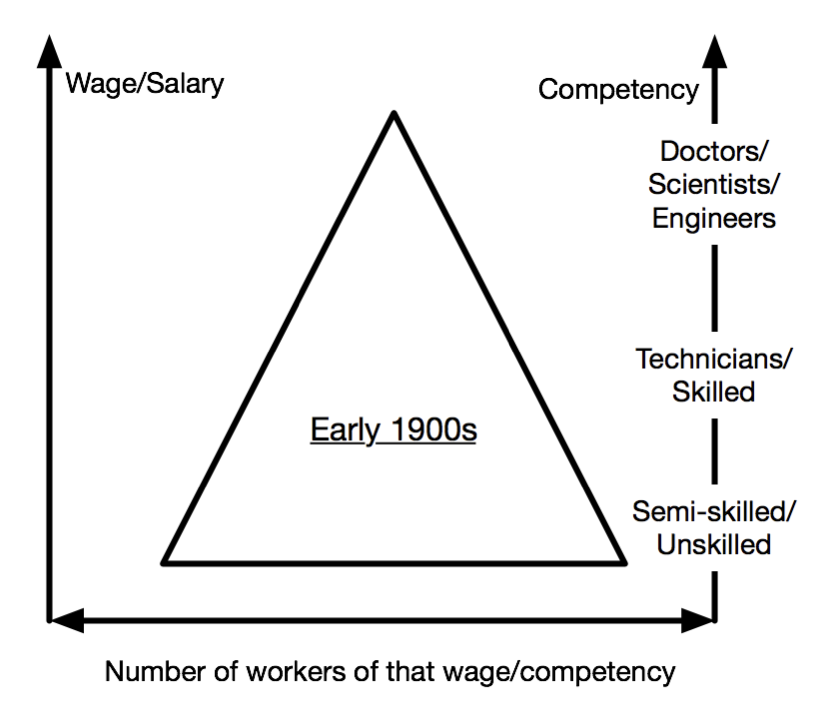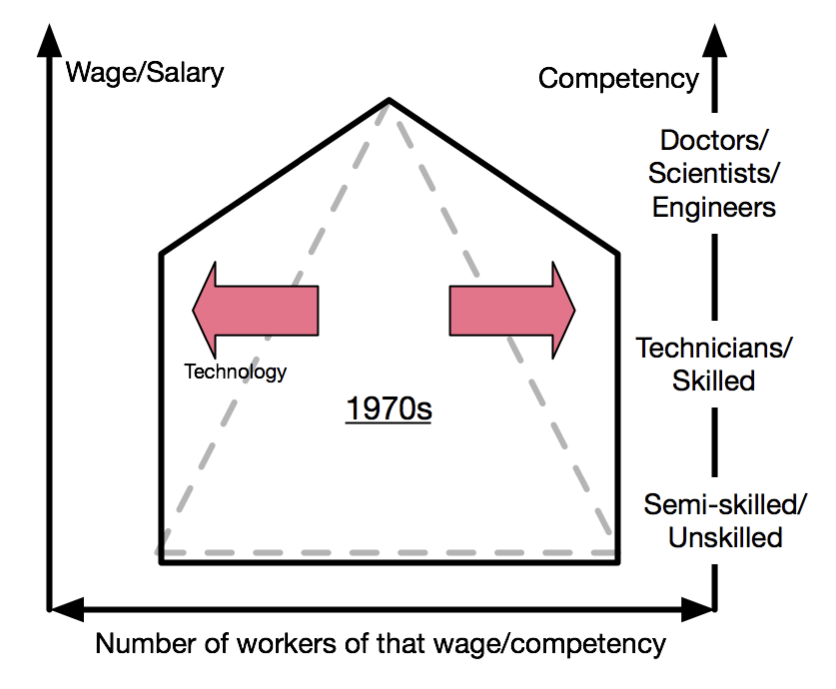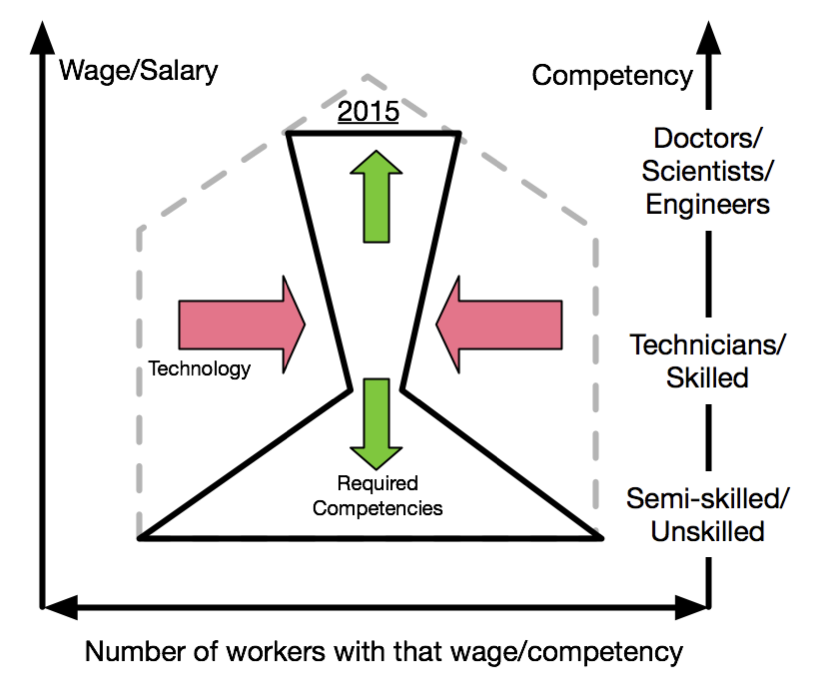Technology as a force for change
Technology as a force for change
Written by John Berry on 6th May 2017. Revised 17th June 2022.
10 min read
 Technology provides a force for change in all businesses. Technologists innovate and develop new technological knowledge and technological artefacts.
Technology provides a force for change in all businesses. Technologists innovate and develop new technological knowledge and technological artefacts.
That technological knowledge helps us do things differently and to innovate within our businesses. The technological artefacts help us do things, but they also do things for us and replace us in things we did previously.
Technology has brought huge business opportunity.
Here are examples. Disruptive technology causes upset in the way firms do business, sometimes causing them to quit markets and shed staff.
- The days of authors funding print runs of tens of thousands of their latest books are gone. Amazon reports 2 books in stock and proceeds to print a few more to exactly match demand. New print technology (allowing a print run of 1 book) means the distributor also becomes the printer and the printer looses that type of work. Overall, books are less costly to print and store and so the price can fall.
- Managers once-upon-a-time had secretaries. They dictated letters for those secretaries to type up. Today those same managers dictate to a computer which replies with a document neatly formatted ready for review. The role of secretary has gone, spawning a few higher competency and more highly paid personal assistants.
- And in the car industry, the famous autonomous work group (AWG) comprising around fifteen skilled technicians, has been replaced by an army of robots. The AWG was considered the most effective way to build an automobile in the 1970s and 1980s. The result of using robots is increased quality and reduced costs.
For those in the firms affected, technology has changed lives. Managers must understand technology as a force for change.
Time
Traditionally, we’ve considered that change always occurred slowly over a long period. But today, change occurs over a relatively short time. Early smartphones (from just 5 years ago) were clunky affairs compared to today’s slick, powerful and functional devices.
 We’ve only really had apps for 3 of 4 years. The age of the app enabled Uber, the cab company, to start in the US and invade taxi markets worldwide. In the Uber example, revolutionary change has taken about 3 years. In a mere 3 years, Uber has risen from nothing to dominant player.
We’ve only really had apps for 3 of 4 years. The age of the app enabled Uber, the cab company, to start in the US and invade taxi markets worldwide. In the Uber example, revolutionary change has taken about 3 years. In a mere 3 years, Uber has risen from nothing to dominant player.
Apps have brought huge functionality to every business. Over the previous forty years or so, such benefit was only available at significant cost, used by skilled operatives and with lower efficiency.
Managers must understand technology and how it will disrupt their businesses in the coming few years. Technologies dramatically affect markets and industries in ever-shortening timescales.
Options and choices
Technology can be harnessed or ignored. But ignoring the march of technology is dangerous for managers. In competitive markets, someone else in the industry will exploit the technology to their benefit and the Luddite manager’s demise.
Technology and humans are a duality. Technology enables humans to do more with less, but technology also replaces humans in the workplace. On the one hand, technology reduces the competencies needed, whilst on the other, humans must grow their competencies to exploit technology.
Businesses that can develop their competencies will win. Those that can’t, or won’t, will loose.
There are three questions to understanding technology:
- How will it affect the processes within the business?
- Over what timescale will the effect be felt?
- How it will affect the competencies needed in the workforce?
These three questions can be played out in a technology impact model shown in three figures below.
Pre-1970
In the early 1900s right up to about the 1970s, the labour market supplying industry and commerce could be considered a pyramid. This is shown in Figure 1 below.

The middle ground in the model was taken up with technicians – skilled craftsmen and women, trained to do a relatively repetitive activity such as fitting out factories and nursing the sick. They earned higher wages because they took longer to learn the job and were of higher competency than their unskilled colleagues.
At the top were the thinkers; the doctors, scientists and engineers. These people did relatively original work and wrote the instructions for the technicians to implement and the unskilled to do.
Compared to today, the use of technology was modest.
1970s and 1980s
Consider now the advent of the modern epoch of technology – the time when perhaps technology really started to make its mark – in the 1970s.
Technology at this point principally became an enabler. Its effect on the labour market structure is shown in Figure 2 below.

Instrumentation meant that the technicians could do more to test and evaluate. Nurses could monitor more vital signs, managers could get dictating and those car-making AWGs could really get effective. Humans were employing technology to be more effective and efficient. Technology was helping humans in the workplace, not replacing them.
The red arrows show the effect of technology as a pressure on jobs.
In the 1970s and 1980s, technology enabled the mid-range technician jobs to improve quality and productivity. Since, broadly, economies were growing, the number of people in this mid segment grew significantly.
Since automation was modest, the numbers in the lower segment stayed relatively static, as did the numbers of doctors, engineers and scientists.
This structure persists today in some industries and in some firms.
Present day and near future
Now roll forward to 2015. The situation describing the present day, and for the near future, is shown in Figure 3 below.
Now technology has automated the technician’s job. Computers do what many humans did. Again the red arrows show the pressure on jobs. This time it causes contraction in numbers.
There are two effects. Firstly, technology enables higher competency staff to do things previously not possible at the budgets available.
An example of this is the government department using an automated spectrum management system (ASMS). This is just a computer system that automatically does the necessary calculations needed to allocate packets of the electromagnetic spectrum to wireless operators (for use in deploying wireless networks) in return for payment of a licence fee.

Until the department acquired an ASMS recently, it employed engineers to determine the rules embodied in these calculations and an army of technicians to do the calculations and communicate with the wireless industry. But there were never enough engineers and the march of technology meant that these calculations were getting ever more complex, needing continuous research to keep up. Because they were a long time in training, engineers were costly and hence the department only employed a few.
The technology and knowledge embodied in the ASMS removed the need for repetitive, mundane calculations. As a result, some technicians could increase their competencies to become engineers. More engineers were therefore available and hence the spectrum management organisation could do more of the complex stuff that stymied it before.
Equally significantly, and overnight, that army of technicians was out of work, pushed out by the ASMS. The computer system also automated much of the lower-level tasks. This meant that there was little growth in semi-skilled and unskilled jobs and hence few lower-competency jobs for those technicians to take up – even if they wanted to.
The green arrows show the movement in competencies needed in jobs.
The government department bought the ASMS. The system vendor’s design engineers embodied in that machine the intelligence and competency needed previously. The competencies now needed were meagre, just taking the machine output and communicating this. The number of workers needed at the lower competencies grew slightly, the number of technicians at the mid level shrank dramatically and some technicians developed to become engineers.
Generalisation
The above example can be generalised. Computers replace technicians. Some move from technician to engineer. And sometimes there’s small growth in number of low-competency jobs too.
For nurses, for example, there’s no skill now in taking blood pressure – just attach the machine and press the button. The machine tells if it’s low, normal or high, given the patient’s age and other characteristics.
For metalworkers turning parts for cars, the skill is in setting up the CNC lathe, not actually turning the parts. A computer does all that. The computer drives the lathe to produce thousands of identical parts to exacting specification.
But for some firms and their workers, technology offers ability to do more. What matters now are what the blood-pressure reading means and what treatment is to be offered, given the result. The nurse moves up to the interpretive, analytical and consulting role of the doctor. But if all that the task requires is to relay the reading back to a doctor in the surgery, the nurse becomes a button-pusher with some people-skills to get the reading done. It could go either way.
So how will technology affect your firm? And how will you react?
- The first option is that you grow your business to adopt technology, whilst continuously developing your people to take those new high-competency roles. You’ll have to pay more for those staff but you’ll charge more because your products and services have more value – you’ll be interpreting, not just measuring.
- The second option is that you adopt technology to enable you to make existing staff redundant, recruiting more at lower competencies and lower cost. You’ll earn less in the market (because competition will drive the price down), but you’ll sustain profitability.
Now, this picture is generalised. There will be markets like tree surgery and home care where technology will remain an enabler because the bulk of the activity involves work that can only be done by a human – for now at least. These customer-centric services will sustain and remain relatively low competency.
But the host of businesses that involve processing data, for example, will be universally invaded by computers running artificial intelligence and statistical computations. Take bookkeeping as an example. It is possible today to load a box of invoices and payments to a scanner, extract the necessary data, sort and verify it, allocate it to cost codes and produce a trial balance. Other than physically offering the documents to the scanner and starting the routine, this can be done without human intervention by a computer running a statistical model.
Technology as a force for change
As with the nurse, machinist and bookkeeper, the reaction to such technology now depends on the firm and its management.
On the one hand, the firm could have re-trained its bookkeepers to interpret the trial balance, and provide further services. On the other, it could simply transmit the result to a high competency accountant, responsible for interpreting thousands of trial balances. Production of the trial balance no longer needs technician skills. That’s done by a machine.
Similarly, the firm could train its nurses to take diagnostic readings from a number of automatic machines such as blood pressure monitors, and then recommend treatment regimes. Or the nurse role could be de-skilled to take readings and relay these to GPs responsible for thousands of patients. Machine operation ceases to be a skill. The skill now is in analysis of symptoms and synthesis of treatment.
As a manager, it’s you’re your business and your choice.
Post publishing note
Charles Arthur, writing in the guardian on 7th November 2015, supported the model in Figure 3 above but suggested that in the longer term, the result will be more extreme. See his article titled Artificial intelligence: 'Homo sapiens will be split into a handful of gods and the rest of us'